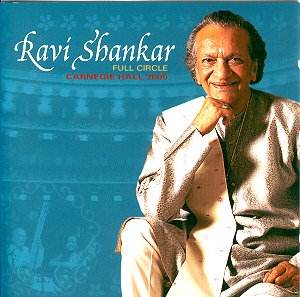A while ago, I reviewed
two early recordings of Ravi Shankar and was very moved by both
of them. Here we have a brand new offering from this artist and his
family, friends and colleagues, and it is no less enjoyable than those
early discs. Once again, this disc has given me a tremendous amount
of sheer pleasure.
Whereas the earlier recordings had an "in your face" quality about them because of the extremely close recording balance. This issue has a much more modern feel about it with a real concert hall balance, so there is much more of an atmosphere around the soloists than before. In addition, there remain the introductions to the audience from the master (thankfully short), plus the responses from the audience. Apart from an appreciative surge of emotion heard in the background, audience noise is mercifully fairly minimal, thus maximising the listener's experience.
On the sleeve note, Ravi Shankar raises the concern that to perform in front of an audience whilst the performance is being recorded tends to inhibit the players because Indian music by its very nature is improvisatory. The duration of a piece for example depends upon the inspiration of the performer and to know that the duration of the recording medium is finite can sometimes cause the player to be less than completely free.
Nowadays, with playing times being extended this is becoming less of a problem and this is certainly not evident in these recordings. The two pieces last about half an hour each and this duration allows plenty of time for the artists to improvise at length in each without showing any inhibitions.
Ravi Shankar is joined in both pieces by his daughter, Anoushka, and it is interesting to hear that she has already in her young years reached such proficiency on her instrument that she is quite able to perform in such exalted company. She also records in her own right, having so far issued two recordings for EMI, presumably with her father's devoted approval. The Indian view that to be able to play this kind of music only after many years of study and meditation is more to do with the intellectual and spiritual approach to the music rather than the technical facility on the instrument. So with the daughter supplying the latter and father providing both, we should not feel that we have been short changed. Indeed, having the two instruments performing together, there is an added richness to the proceedings.
The first of the two ragas is based upon the short phrase karmasu kausalam from the 700 stanza Hindu classic piece of literature called Bhagavad Gita. The two words describe the extraordinary ability in action and the exquisite things attainable when one's inner resources are focussed on the excellence of an activity without undue emphasis for its outside impact or rewards. This humble approach to activities is personified in Shankar's approach to his art and so these performances are all the more telling, given this approach.
The two pieces are complementary, the first being largely contemplative in nature, developing into the exhilarating atmosphere and the musicians bringing the audience with them to a very exciting conclusion. Great stuff.
John Phillips

![]() Ravi Shankar - Sitar, Anoushka
Shankar - Sitar, Bikram Gosh - Tabla, Tanmoy Bose - Tabla, Ajay Sharma
- Tanpura and Barry Phillips - Tanpura.
Ravi Shankar - Sitar, Anoushka
Shankar - Sitar, Bikram Gosh - Tabla, Tanmoy Bose - Tabla, Ajay Sharma
- Tanpura and Barry Phillips - Tanpura. ![]() EMI CDC5 57106-2 [54.51]
EMI CDC5 57106-2 [54.51]